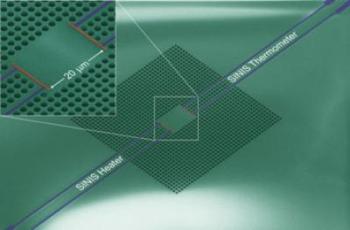Mar 21 2014
Thermal conduction is a familiar everyday phenomenon. In a hot sauna, for instance, you can sit comfortably on a wooden bench that has a temperature of 100C (212F), but if you touch a metallic nail with the same temperature, you will hurt yourself.
 A phononic crystal device fabricated in silicon nitride (SiN) using electron-beam lithography. Green = SiN, blue and red lines = aluminium and copper heaters and thermometers, and black areas = holes. Credit: University of Jyväskylä
A phononic crystal device fabricated in silicon nitride (SiN) using electron-beam lithography. Green = SiN, blue and red lines = aluminium and copper heaters and thermometers, and black areas = holes. Credit: University of Jyväskylä
The difference of these two experiences is due to the fact that some materials, such as metals, conduct heat well, whereas some other materials, such as wood, do not. It is therefore commonly thought that thermal conductance is simply a materials parameter. Now, researchers at the University of Jyväskylä, Finland, led by Professor Ilari Maasilta, have demonstrated for the first time that it is possible to change the thermal conductance of a material by tuning the wave-like properties of heat flow, by orders of magnitude, using nanostructuring. The results were published on 19 March in Nature Communications. The research was funded by the Academy of Finland.
Theoretically, it has been long known that heat can be thought of as a collection of the motion of many different kinds of waves; atoms vibrate, but not randomly. These little wave packets follow the laws of quantum mechanics, which leads to that only certain ranges of wavelengths are excited, depending on the temperature. The situation is very similar in thermal radiation, where the wave packets or particles are photons (visible light also consists of photons). In the case of material vibrations, the particles are called phonons, theoretically introduced by Albert Einstein over a hundred years ago.
The wave nature of phonons has never before been used to control heat transport. Until now, thermal transport has been engineered by adding one material (e.g. nanoparticles) inside another, or by changing the roughness of the surfaces. In both cases, phonons scatter more and thus carry heat less effectively. Now, the University of Jyväskylä study shows that it is possible to change the phonon thermal conductance strongly based on the wave properties of the phonons. This was achieved by fabricating a nanoscale mesh structure (a so-called phononic crystal), whose period is of the same order as the wavelength of the phonons that carry heat, about one micrometre in this case. The phonon waves interact strongly with the phononic crystal structure and change their speed by almost an order of magnitude. Because the waves move much more slowly, the thermal conductance is significantly reduced. The experiment was performed at a temperature near absolute zero in order to increase the wavelength of the thermal phonons to a length scale, where fabrication using common nanofabricating tools is possible.
In the future, the demonstrated concept can possibly be used in many ways. At low temperatures, there are direct applications in the development of ultrasensitive radiation detectors, where the control of heat transport is essential. This kind of applied research is also conducted in Professor Maasilta's group. In addition, if the demonstrated concept can be made to work at room temperature range, it might have an impact on the future development of more efficient thermoelectric devices, which can be harnessed to generate electricity from waste heat.
Source: http://www.aka.fi/